Temporary exhibition : SAKAI'S TREASURES
更新日:2025年7月19日
July 19 (Sat) – September 7 (Sun), 2025
<Open daily> 9:30-17:15(last entry 16:30)
<Closed> Mondays except national holidays
●Sakai City Museum(Daisen Park,2 Mozu Sekiun-cho,Sakai-shi,Osaka 590-0802)
ADMISSION
Adults : 200 yen (160yen)
High School / University Students : 100 yen (70yen)
Elementary / Middle High School Students : 50 yen (30yen)
※Fees in the parenthesis are for groups of 20 or more.
※Residents of Sakai City of 65 and above are admitted free of charge.(ID required)
※Persons with a handicap are admitted free of charge.(ID required)
※Elementary or middle high school students living or attending school in Sakai City are admitted free of charge.
Greetings
Since its opening in 1980, the Sakai City Museum has collected a wide variety of artworks and materials. They include many articles that have come to the museum after many years of being treasured by Sakai citizens.
Focusing on the colors of gold and black, this exhibition features such precious articles and related works from the museum’s collection, as well as from the collections of those related to the city. Enjoy experiencing the history and culture of Sakai through artifacts in brilliant gold and in profound black, which symbolize the respective eras.
Chapter1 Fascination of Gold
Gold is a rare metal with a long history of human use. Its physical property of being free from oxidation and rust enables gold to remain brilliant for a long time, fascinating people around the world. With immutability as a distinctive feature, gold has evoked reverence and admiration from people, who have viewed it as a symbol of eternity, especially the eternity of youth, and immortality. Consider what fascinations gold has exerted over human beings while looking at the exhibits.
Small knife in a gilt copper sheath
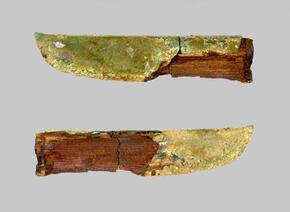
This is a small knife with a short blade. Kokugakuin University has found that this small knife and other relics that it obtained in 2024, including metal armor parts, are likely to be from the burial goods at the Nintoku-tenno-ryo Kofun in Sakai City. At the mounded tomb, in 1872, a stone chamber and a stone coffin were discovered under the southern slope of its square part, and drawings created then still remain. The recently discovered relics are thought to be related to the stone chamber and coffin. This small knife has an iron blade housed in a sheath decorated with gilt copper plates.
Metal armor parts
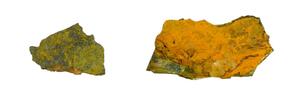
Armor with gilt copper decoration is depicted in a copy of a drawing created when a stone chamber and a stone coffin were discovered under the southern slope of the square part of the Nintoku-tenno-ryo Kofun in 1872. These armor parts are gilt copper pieces and are thought to be related to the armor with gilt copper decoration depicted in the drawing.
Western-style chest with a floral maki-e and mother-of-pearl inlay design
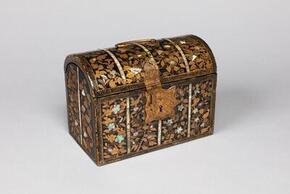
Japanese lacquerware items combining jet-black lacquer, gilt maki-e, and mother-of-pearl inlay were popular exports to European countries, especially Portugal and Spain, in the 16th and 17th centuries. Some of them were designed to be convenient for European users. This Western-style chest is completely covered with depictions of a variety of plants, including camellias, ume plum blossoms, morning glories, cherry blossoms, and bellflowers. It is shaped in a Western style but decorated with Japanese plants.
Folding screen painting of the Sumiyoshi Festival
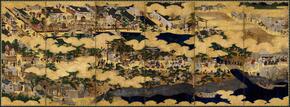
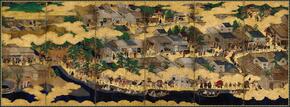
This folding screen painting depicts a scene from the Sumiyoshi Festival, a procession of people carrying portable shrines of Sumiyoshi-taisha Shrine marching to Shukuin-tongu Shrine in Sakai, the resting place for the portable shrines. The screen depicts a path of approximately five kilometers, from Sumiyoshi-taisha Shrine to Shukuin-tongu Shrine. At Sumiyoshi-taisha Shrine, four portable shrines are leaving for the procession. At the end of the path is a lively procession of parishioners, flamboyantly dressed like warriors or Europeans, escorting the portable shrines, marching through the streets of Sakai. In the painting, you can also find humorous depictions of several people dressed like warriors wearing a horo (balloon-like protector) sitting on a portable stool for a rest.
Heart Sutra
The Heart Sutra is a concise summary of Buddha’s teachings. In this scroll of indigo-dyed Japanese paper, the Heart Sutra is written in a gold pigment made by mixing gold dust with animal glue. The scroll also has a painting of Sakyamuni preaching to people.
Image of Amitabha Tathagata
The name “Amitabha” comes from a Sanskrit term meaning “unmeasured” and “boundless,” while a tathagata is an enlightened being. Amitabha Tathagata is a Buddha governing the Western Paradise. In particular, in Japan around the 11th and 12th centuries, it was a widespread belief that chanting “ namu-amidabutsu” to Amitabha Tathagata allowed one to go to Paradise after death, inspiring general reverence for Amitabha Tathagata. This work depicts golden Amitabha Tathagata shining in sharp contrast with a dark background, with the Urna (whorl of white hair) on his forehead radiating golden rays of light. His attire is decorated with fine patterns created with the kirikane technique of cutting gold leaf into tiny pieces and applying them with glue made from algae or animal parts.
Star Mandala
The belief that stars and other celestial bodies are related to the fate and lives of people has a long history. People have offered prayers to stars at festivals. The Star Mandala is the principal object of worship in religious services for stars. It represents the sun, the moon, and stars in the form of Buddhas against the background in dark blue.
Chapter2 Love for Black
The Japanese language has many terms that represent the subtle nuances of black, such as “nureba-iro” (“the color of wet crow wings,” or glossy black) and shikkoku (“the color of black lacquer,” or jet black). The highlights of this chapter include India ink paintings, which depict various landscapes with black only but sometimes give us a feeling of colors, and calligraphic works, which capture the exciting movements and power of brush strokes, as well as black-lacquered artifacts whose names include the term “shikkoku.” Enjoy viewing a wide variety of renderings of black.
Landscape on a folding screen
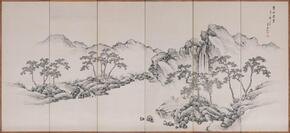
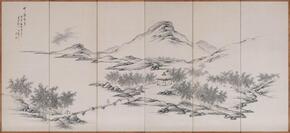
In this painting, India ink with a strong blue tone is used, and only small parts, such as figures, are faintly colored. Taking advantage of different shades of India ink, strokes, and the whiteness of the paper, this painting, despite being in black, is intended to inspire viewers to imagine colors and the subjects. The remote mountains and the night sky are painted in pale ink, while bamboo joints and pine barks are painted in slightly dark ink. The waterfall and the moon are depicted by utilizing the whiteness of the paper. Can you imagine the colors of these subjects?
Letter written by Toyotomi Hideyoshi
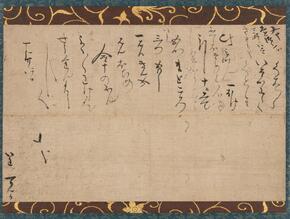
In history, dignitaries often had other people write letters on their behalf. However, this letter was handwritten by Toyotomi Hideyoshi himself. In the letter, the warlord says: “I will send you a bucket of mandarin oranges, so share them with your family members and savor them.”
Chapter3 Encounter between Gold and Black
The final chapter is dedicated to works that combine gold and black. In sharp contrast with each other, shiny gold and jet black can coexist and even perfectly complement each other.
Kimono beloved by Yosano Akiko
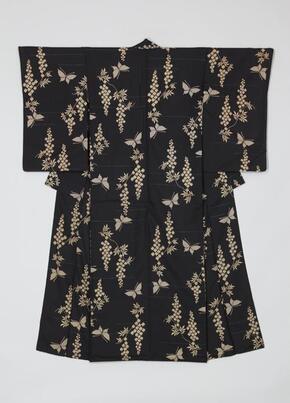
This beautiful kimono is scattered with butterfly and wisteria patterns against a black background. The tanka poet and author Yosano Akiko gave advice to working women: “Be careful about your personal appearance. Be dressed beautifully.”
このページの作成担当
文化観光局 歴史遺産活用部 博物館 学芸課
電話番号:072-245-6201
ファクス:072-245-6263
〒590-0802 堺市堺区百舌鳥夕雲町2丁 大仙公園内 堺市博物館
このページの作成担当にメールを送る